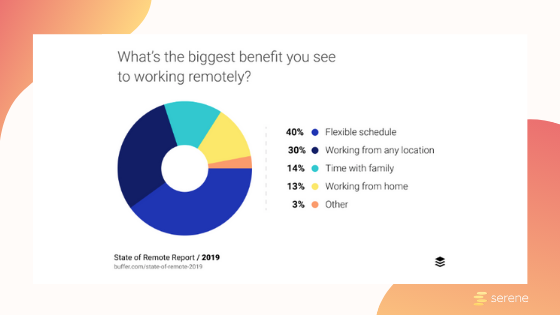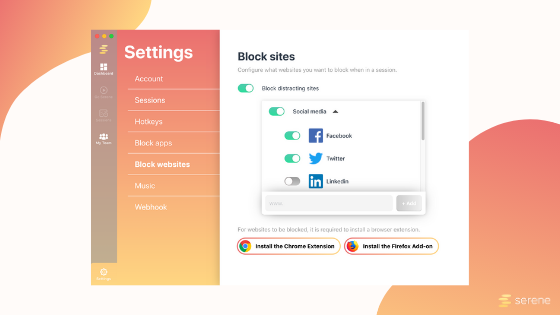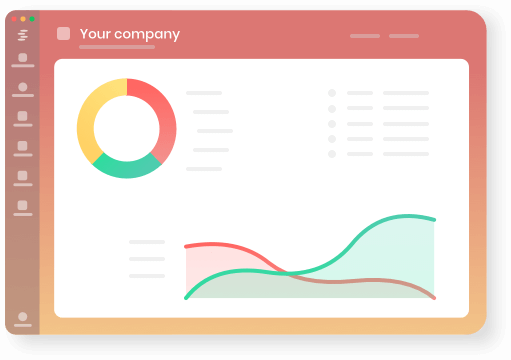17 Remote Working Benefits for Employers and Employees
Thanks to Wi-Fi and communication technology, many workers are no longer tethered to a desk job and can work from home or even from the road. Since 2005, regular remote work among non-self-employed people has grown by 173%, and across the globe, more than half of employees work from home at least once a week.
Telecommuting, work-from-home, telework—whatever you call it, remote work is on the rise and here to stay. Buffer’s 2019 State of Remote Work survey found that 99% of the 2,471 respondents said they’d like to continue working remotely at least some of the time or for the rest of their career.
But all of this hype about working remotely brings us to an important question: How exactly is remote work helping us? Let’s take a look at 17 remote working benefits for employers and employees, along with a host of relevant studies about them.
👩💻 Benefits for Employees
1. Enjoy a Flexible Schedule
In its 2019 State of Remote Work report, Buffer found that the number one cited benefit of remote work was a flexible schedule, which scored higher than the ability to work anywhere.

Remote workers generally have more control over their schedules, able to shift their start and end times, their locations, and which days they work. Flexible schedules make it easy to book doctors’ appointments, pick up the kids from school, fit in an afternoon run, and so much more, without needing to ask for time off.
And all of this is good for well-being. A 12-month study involving a Fortune 500 company found that workers who participated in a flexible work program reported less stress, higher job satisfaction, and reduced burnout.
2. Boost Job Satisfaction
A Penn State meta-analysis of 28 studies found a positive correlation between job satisfaction and remote work, partially due to the subjects’ increased “perceived autonomy.” It turns out we like to control how, when, and where we work! Or at least feeling like we do.
3. Better Work-Life Balance
Because remote workers have flexible schedules and can work from home, their work-life balance can improve. In fact, a report from the Centre for Economics and Business Research found that remote workers get an extra 105 hours of leisure time per year than office employees.
4. Get More Work Done
In 2010, researchers at Stanford University ran a nine-month study to determine if working from home really works. They recruited 249 participants from a Chinese travel agency and randomly assigned half to the remote work group and the other half to the control group.

The results showed a 13% increase in productivity for the home workers, including a 9% boost in the minutes worked during their shifts and a 4% boost in calls per minute worked. This improvement was attributed to a reduction in breaks, time off, and sick days, as well as the quiet of working from home.
5. See the World While You Work
One of the biggest draws to telecommuting, especially for those with wanderlust, is the ability to travel the world while working from a laptop.
Digital nomads, those who work online while travelling, are growing in number. Pieter Levels, digital nomad and founder of Nomad List, estimates there will be 1 billion digital nomads by 2035.
If the best indicator of the future is the past, then it’s clear that at least interest in digital nomadism has been growing rapidly during the past decade. Just take a look at this Google Trends chart of searches for the term “digital nomad” since January 2010:
6. No More Commuter Stress
Studies have shown that commuting, whether by private car or public transit, is a health risk. A 2001 study by German scientists found that commuters were twice as likely to complain of ailments such as pain, dizziness, and severe sleep deprivation than noncommuters. The stress of getting to work can raise your blood pressure, cortisol levels, and adrenaline levels, putting you at an increased risk of a heart attack.
But telecommuters don’t have to worry about that. The longest work commute they typically make is walking from the bed to their home office.
7. Save Money on Transportation
Speaking of commuting, because they don’t have to do it often, remote workers stand to save a lot of money. The average Brit spends £56,000 on petrol in their lifetime, while the typical American household pays $2,000 a year to fuel their cars.
8. Live Where You Want
Many people choose where they live based on the location’s proximity to their workplace. Some even stay in a place they hate simply because it’s close to their office (and remember, commuting is stressful).
As a remote worker, however, you’re no longer tied to a city because your job is there, nor do you have to limit your job search to the surrounding areas.
9. Reduce Distractions
It’s much easier for a telecommuter to go into “Do Not Disturb” mode on their phone or on Slack than it is for an office worker to avoid unwelcome drop-ins from chatty coworkers. Because remote work gives employees more control over their environment, in theory, they should be able to lower distractions.

🕴 Benefits for Employers
1. Save Money
Companies with a remote, distributed team can save money in a myriad of ways, including:
- No more having to pay rent. Any company, regardless of location, can save money if they go remote and reduce or eliminate the need for office space.
- Reduction in salary. In one study, researchers from Princeton and Harvard found that the average worker is willing to take an 8% pay cut to work from home. Savvy employers can work this into their hiring negotiations to create an arrangement that’s a win-win for everyone.
- Decreased turnover. Remote work makes for happier employees, and happier employees tend to stay longer, which is better for your bottom line.
- Better employee performance. Studies suggest that remote workers show increased productivity, which means your payroll dollars can go even further when you allow employees to work from home.
The Chinese travel agency in the Stanford study saved about $2,000 per year per work-from-home employee thanks to reduced office space, improved employee performance, and decreased turnover.
2. Attract Top Talent
- Expand your talent pool. If you expand your search from your city to the entire world, you’ve just transformed your talent pool into a talent ocean, increasing your chances of finding the best person for the job.
- Attract top talent with this enticing benefit. Remote work is a highly sought-after benefit. In an Indeed survey, nearly half of respondents said remote work was an important factor when choosing a job.

3. Retain Employees
The two-year Stanford study showed a decreased rate of employee attrition for telecommuters. And as we went over above, that saves employers money.
4. Reduce Sick Leave
When people work from home, they’re less likely to need to take the day off if they’re sick because they don’t need to worry about being contagious to their coworkers. Half of the remote workers surveyed by Indeed said they took fewer sick days due to telecommuting.
5. Help the Environment
In 2017, transportation was the largest source of greenhouse gas emissions, according to the U.S. Environmental Protection Agency. Having a remote team helps the environment since workers no longer need to drive to work.
6. Less Stress on the Traffic Grid
Gridlock is every commuter’s headache. But by switching to working from home, telecommuters decrease their overall travel time by 14 minutes and increase their likelihood of using non-motorised transport by 77%. This can result in less stress on the traffic grid, which means less stress for everyone on the road.
7. Increase Diversity
We became too mono-cultural. Our users are the world, but our hiring radius was only 10km
Toggl CEO & Founder Alari Aho – remote.co
Hiring remote workers from around the world makes for a more diverse team. In fact, it’s one of the reasons time tracking software company Toggl decided to go remote.
8. Improve Your Ability to Evaluate Work Quality
Basecamp co-founder Jason Fried points out another interesting remote working benefit for employers: Unlike in an office, you can’t evaluate a remote employee’s performance by what you saw them do at their desk; you can only evaluate the work itself.

“What you’re left with is ‘what did this person actually do today?’,” Fried writes, “not ‘when did they get in?’ or ‘how late did they stay?’ Instead it’s all about the work produced.”
🧰 3 Case Studies:
Buffer
Buffer is a rapidly growing software company with a distributed team of 90 people in 15 countries. Being remote doesn’t seem to hold this team back. According to the latest financial metrics Buffer founder Joel Gascoigne shared on Twitter (he does this regularly), in October 2019, the company hit an Annual Recurring Revenue milestone of $22 million and boasts 75,000 customers.

Gascoigne recognises remote work is best suited for those who are self-motivated. Because of this, as he writes on the Buffer blog, “During the hiring process, we look especially for people who have worked as freelancers or on startups.”
He also chooses to embrace multiple time zones as an advantage, rather than a burden. Because the team is distributed across the globe, Buffer is able to reply to 80% of its customer emails within one hour. The time difference helps with development, too, as there’s always someone up and coding.
The State of Arizona
Many people think of remote work as a new trend limited to hip startups and tech companies, but that’s not the case! The state government in Arizona began testing telecommuting long before it was cool.
Since 1996, all major state departments have offered a telework program. Arizona enlisted the help of an outside evaluator to determine if its early remote work was beneficial, and the results proved positive:
- Increased productivity: After the first six months, nearly all teleworkers and most of their supervisors believed there was a boost in productivity because of remote work.
- Improved morale: Because they had more control over their work schedule, teleworkers reported higher morale.
- Better communication: There was more communication between supervisors and employees about goals and expectations.
Bynder
In the summer of 2018, Bynder, which at the time had 350 employees in seven offices around the world, held its second annual Remote Week experiment. They closed their offices so their employees could work from any location.
Here are a few of the findings from Bynder’s Remote Week experiment:
- Employees were happy working remotely. Seventy per cent of employees reported feeling happy and relaxed while working from home.
- Commuting is stressful and time-consuming. Many of Bynder’s employees felt that one of the biggest benefits of Remote Week was that they saved time and money by not having to commute to work. They said the daily commute was a big stressor.
- Communication is important for successful remote work. Because they couldn’t see each other in the office, employees said communication tools were crucial for building trust. Almost 90% of them found it useful to use Zoom, Google Hangouts, and Slack to keep in touch during the workday.
💡 Interested to go remote?
With all the benefits of working remotely, it’s no wonder a growing number of companies and workers are opting to do so. But as with anything, there are downsides to remote work, such as loneliness, weaker coworker relationships, and in some cases, higher stress levels.
Whether you aspire to join the work-from-home workforce or become a digital nomad and roam the planet, weigh the benefits and drawbacks before deciding whether remote work is right for you.








